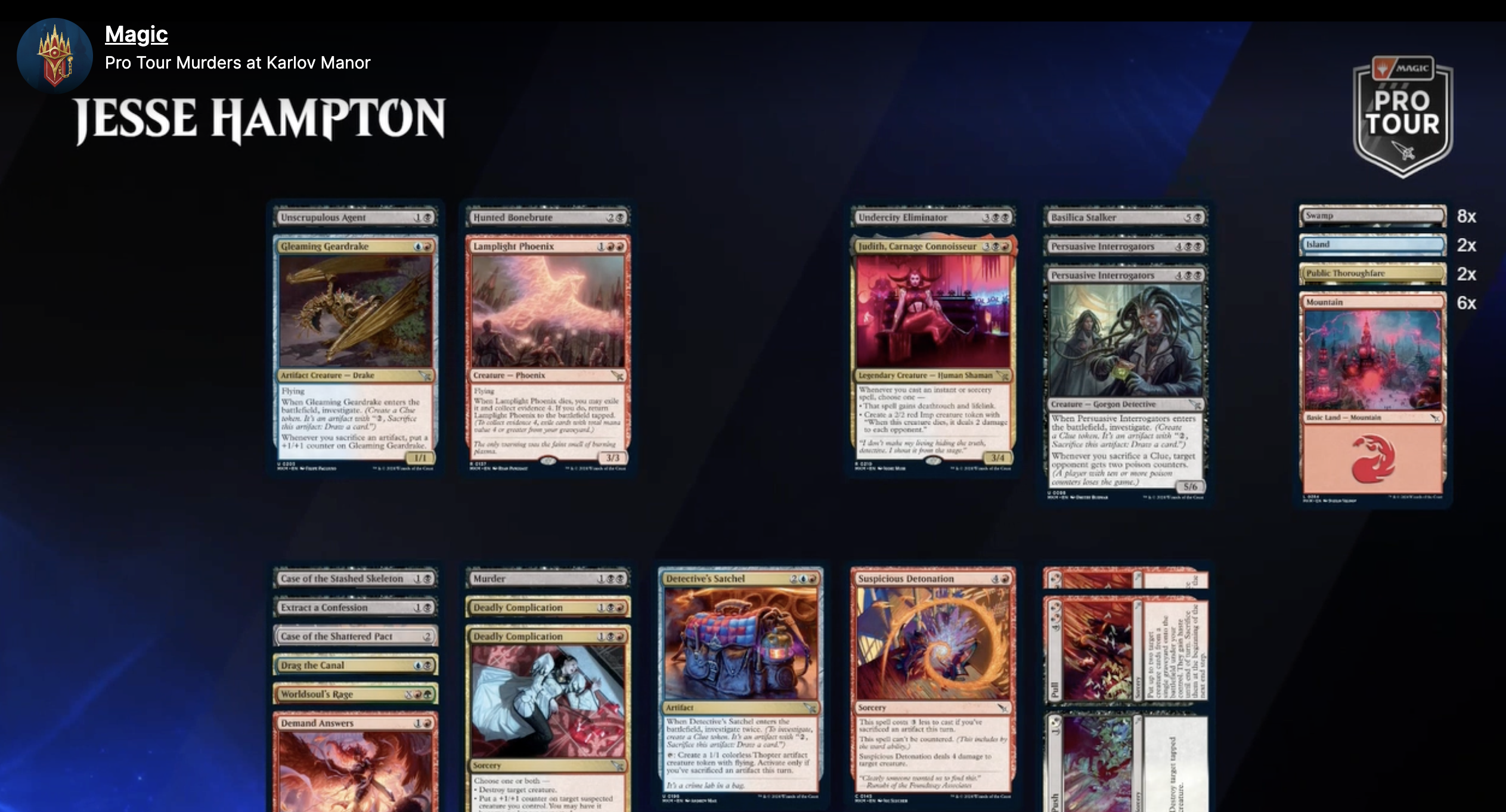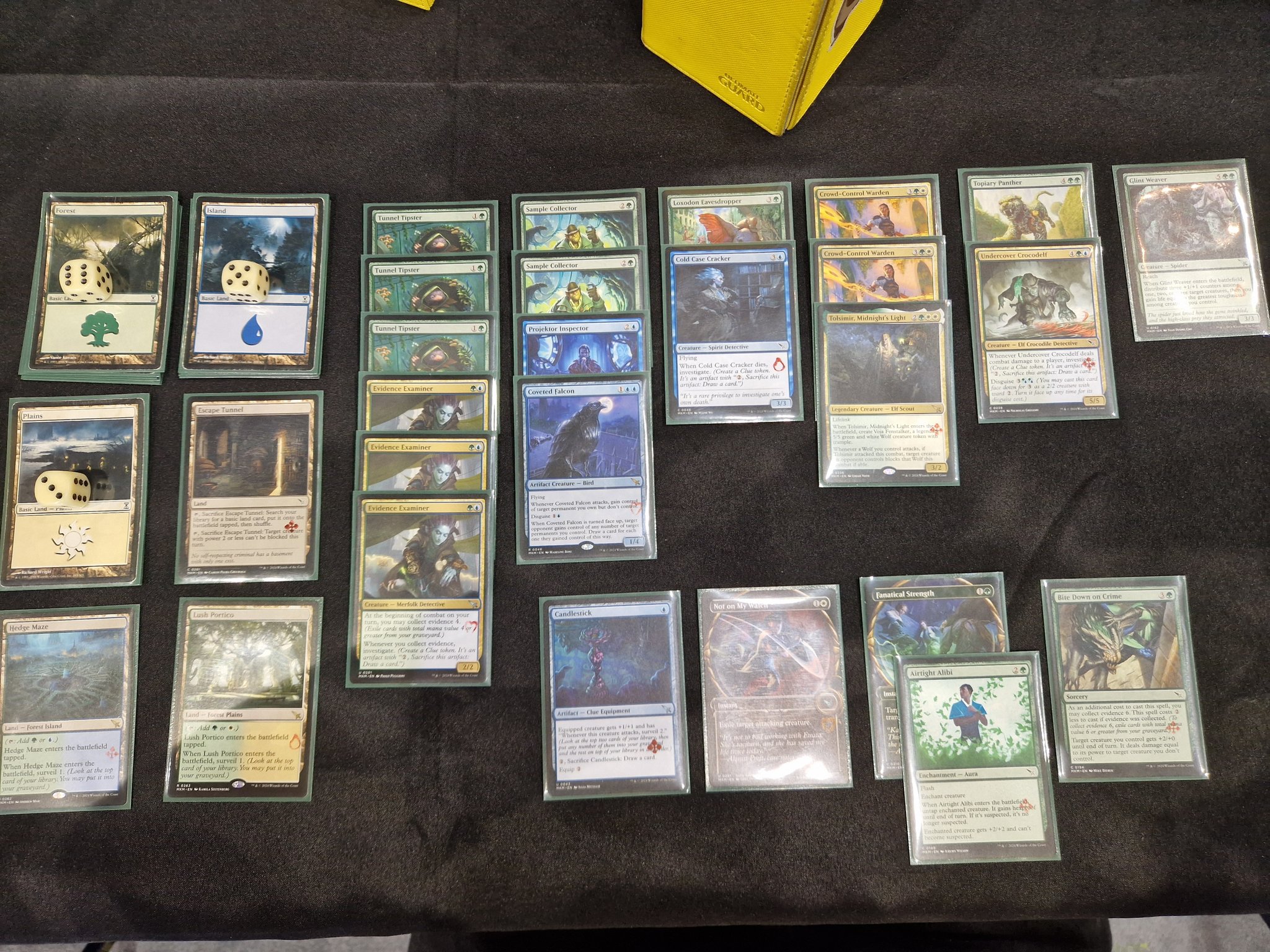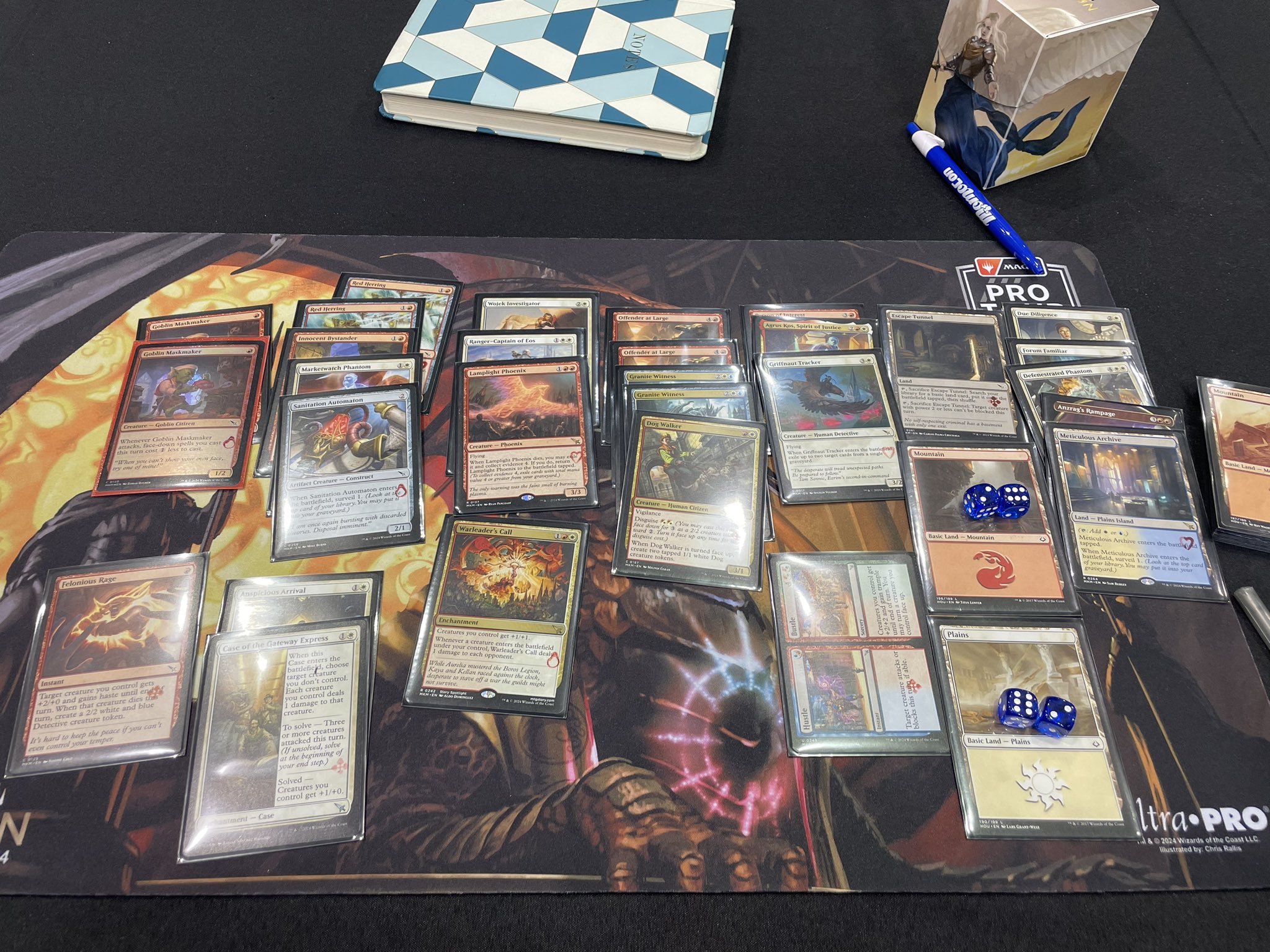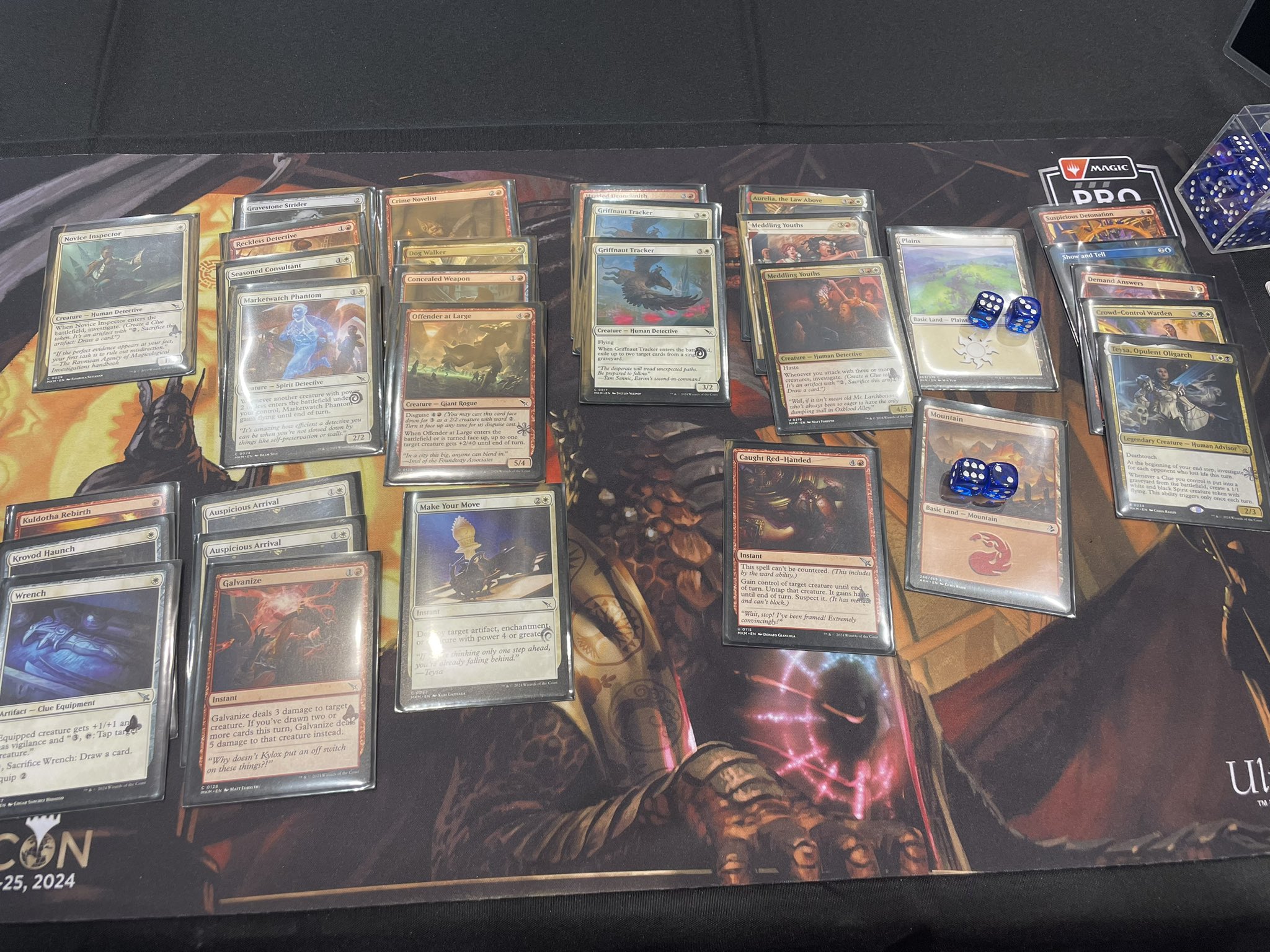Getting Cheeky at the PT
02/25/2024
So, this has been a pretty good weekend for me. I went 4-2 in limited and 7-3 in constructed at my first pro tour!
This article will be about my thoughts on the MKM limited format, as well as my thoughts on playing high-level limited in general. I have also written another article about my constructed deck, Jeskai Creativity - you can find that one here.
The last match I played at the Pro Tour was against Simon Nielsen - I lost that win-and-in to his Boros Heroic deck, guaranteeing that I would not be making top 8. It was a bit disappointing of course, but as many can attest to, Simon was a wonderfully friendly opponent.
After the match we talked for quite a bit, catching up a bit with each other (we were already a bit acquainted from the time I helped half of Team Handshake test for Worlds 2022). And, naturally, the conversation turned to limited.
Simon mentioned that one part of Team Handshake's strategy for this draft format was to take fixing highly - he quoted his teammate Karl as describing MKM as "cube-like", due to the higher density of rares. And from what I heard from other sources, another part of their strategy was also to avoid white, as they thought it would be contested and too shallow. Instead, they liked the blue and black colors the most.
Now, there definitely is some merit to this kind of strategy. For one thing, it's a good way to not completely trainwreck - if you've identified that white is a strong color and will likely be contested, staying away from that color and focusing on weaker, less contested colors will make it harder to end up in a spot where the colors you tried to draft dry up, leaving you with no good direction to go.
But at the same time, this strategy doesn't have a lot of upsides. If you're going in unwilling to draft the best color, you're less likely to have the best deck at your table. As Ben Werne put it on the Lords of Limited podcast, it's good to have UB be a tool in your toolbox, but you shouldn't just assume you're always going to have to use it.
And funnily enough, my day 2 PT draft was an excellent example of the weaknesses of this strategy. Specifically, I was in that pod with both Simon Nielsen and Jesse Hampton - and I believe the seating order involved Jesse passing to Simon, who was passing to a third player who was passing to me. And while Jesse got a clunky Rakdos deck splashing blue; and Simon got an okay Bant deck that was a bit lacking in interaction; I got passed an extremely strong Boros deck.

Jesse's deck, except that there should be a Surveillance Monitor

Simon's deck

my deck
People wondered how I got such a good draft deck in a day 2 pod at the PT - this is how. Team Handshake metagamed a bit too much for their own good, leveled themselves a bit, and ended up both going 1-2 in this pod, as they let better decks pass them by.
Still, though, I can't say that their thought process here was without merit - Simon and Jesse both 3-0'd their first draft, after all. And I certainly agree with their claim that you should take fixing very highly this set - Escape Tunnel is firmly among the top 10 commons of the set for me!
But I think that there's a much better way to navigate high-level draft pods than making blanket decisions on which colors should be avoided and which should be sought after. All it takes is a bit of willingness to get a bit cheeky.
Part 1: The Fundamentals of High-Level Drafts
When I say "high-level drafts", what I mean is specifically 8-player pod drafts where all or most of the players have at least some degree of competency. Both the pod draft dynamics and the dynamics of drafting against good players are important here.
Of course, you could argue that some PT draft pods might not even reach this threshold - PT players are notoriously underwhelming at draft sometimes, as there is a bigger focus on constructed. But at the very least, almost everyone at the PT will have thought about the set on a strategic level.
Notably, this is significantly different from how Arena drafts and MTGO leagues work - not only do those forms of draft not have in-pod play, they also will often contain drafters that really don't know what they're doing, whether they're a new player, new to drafting the set, or just not great at draft in general. There's just way too many people who play Magic for this not to be the case.
Compared to Arena drafts and MTGO leagues, high-level drafts are much more likely to have the good cards taken from packs earlier. You will almost never see good cards wheel, and top commons will be snatched up quite quickly. So, you're naturally going to have fewer good cards to work with, and will more often need to reach further into mediocre cards to fill out your deck.
As a byproduct of this, it will also often be harder to support synergies in pod drafts. Since your card quality will be lower, you'll also just have less leeway to pick and choose the exact cards you need for a specific synergy. Of course, this isn't to say that you should avoid synergies! You should just be cognizant that they will likely be less supported than usual.
These reasons and more are why it's so important to practice high-level pod drafts when doing prep for a PT or similar event - random Arena and MTGO drafts are just not going to cut it. I often refer to these pod drafts as "scrappy" - you're working with fewer resources, so you need to know how to make the most out of those resources, and you just can't get that practice if you're getting
Dog Walker P1P6.Part 2: Making the Most out of the Scraps
In my experience, one of the most important skills in high-level drafts is being able to work with what you're given, whatever that is. Since you're generally working with fewer resources draft-wise, you have less choice, so you'd better be able to make do.
So naturally, it's very important to know how to use every single card in the set, no matter how bad they might seem. If you can eke out advantages from those 23rd cards that you got 10th pick, then you'll never trainwreck.
Scrappy Cards
One general category of cards that can excel more than you'd expect in this environment are large, clunky creatures that are perhaps generally under-rate but have the benefit of being able to just tussle in combat in a low-resource game.
Think cards like
Haazda Vigilante, Rubblebelt Braggart, or Basilica Stalker. These cards are often fairly mediocre at 5+ mana, but sometimes you'll just play it out and it will just win the game by hitting your opponent repeatedly as they don't have anything that deals with it efficiently anyways.In some ways, this is just about fundamentals - as synergies break down and players are playing with less powerful cards, games devolve into being more like core sets. More often, what will matter will be power and toughness, removal, and card advantage.
Hence, you can also include other kinds of inefficient spells here - any card draw or removal that's generally a bit clunky can certainly see some play, specifically in lieu of more efficient options.
Cheeky Cards
There's also a category of cards I like to call "cheeky". These are often cards that can have a lot of upside, but are generally not considered particularly good because they also have some poor downsides. The classic examples here are auras - cards like
Due Diligence.The thing is, the usual reason not to put these cards in your deck because you have better cards that don't have such bad downsides. But if your options are limited, it's better to have some amount of power and upside, even if that comes with some risk.
Plus, you can often lean into these "cheeky" cards to maximize their upsides! With something like
Due Diligence, you can make sure to have a low curve to take advantage of it pushing damage. Other cards might be "cheeky" in that they require some amount of synergy - like putting Expose the Culprit in a deck with multiple copies of Greenbelt Radical.Almost every card in the set will have some use, and the thing that separates okay drafters from great drafters is being able to identify these niche uses.
Draft Decks, Not Color Pairs
One of the biggest pieces of advice I like to give people is to "draft decks, not cards". Envisioning what your final deck will look like and how the cards you're picking will fit into that deck is an essential skill, and will do you a lot better than simply taking cards because of an abstract concept of "strength".
Similarly, at a high level, I would also like to assert that you should "draft decks, not color pairs"! Color pairs do not produce monolithic decks, and even decks in the same colors with very similar strategies will have many different properties.
This is more evident at a high level, as it will be comparatively harder to draft the platonic ideal of a color pair. So naturally, you'll more often have to turn to more unconventional decks, perhaps using unconventional cards.
And this leads to my final issue with Handshake's strategy - I just don't think an active color bias is the right level to be thinking at in high-level draft pods. As long as you know how to use all the cards, you should be able to navigate a draft by identifying what the strong cards you're seeing are, and identifying what other cards they work with. Colors are just too broad of a category to base your decision on.
Part 3: An Example - Unconventional Boros
I'll close out this article with a short analysis of my day 1 draft deck, which was also Boros and also 2-1'd, but was a lot more unconventional than my day 2 draft.

my day 1 draft
The main thing that put me on my track for this draft was a P1P1
Aurelia, the Law Above, followed by P1P8 and P1P9 Meddling Youths.Now, Meddling Youths isn't a particularly strong Boros card - it's kind of expensive compared to the rest of the deck, and runs at odds to
On the Job, which is generally better than it.But it's certainly not unplayable! And you could perhaps call it a bit of a scrappy card - 4/5 haste can very much end games on its own. So with three 5 mana 4 power hasty creatures by the end of pack 1, I was pretty ready to lean into that as one of the centers of my deck.
So what goes well with Meddling Youths? Well, you obviously want to go wide - but I didn't find very many ways to do that. No
Inside Source or Person of Interest, and only one Dog Walker.However, I did pick up a
Kuldotha Rebirth late in pack 1, which is normally not a great card because its fail case is pretty bad. But since I really wanted to go wide, I decided to lean into that, taking and playing a few more artifacts like Wrench and Harried Dronesmith, and even an artifact synergy card in Crime Novelist.I didn't find any copies of
On the Job this draft to help augment my 1/1s going wide, so I fit other cards into that slot - Concealed Weapon and Wrench are certainly worse than On the Job, but they're still completely servicable.And finally, the nature of having 5 mana haste creatures was another thing that warped my deck a bit. I valued
Griffnaut Tracker more highly than usual, as a 3/2 flier was just a good statline to pair with Meddling Youths due to the extra damage pushed. And I took and maindecked a copy of Caught Red-Handed, again for the purpose of pushing more damage with my hasty attackers.All of these decisions were small. And they weren't necessarily even that hard - it's not like I took these cards over copies of Inside Source and On the Job, I definitely wouldn't have done that. But I was confident in my ability to make this Boros deck work even without many of the premium white cards, and was rewarded with a deck that has a lot of weird-looking card choices but ultimately performed quite well!
So yeah, don't avoid white this set, even in high-level pod drafts. Instead, learn how to use all the parts of the set, from the best Boros decks, to blue and black controlling decks, back to all of the other, less used Boros cards in the set.
#FreePalestine | Consider donating to UNWRA or PCRF, supporting protesters locally, and educating yourself.
